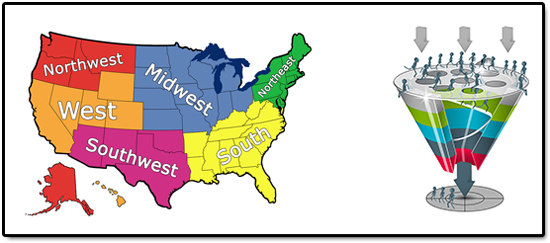5 min read
Inside Sales Management Debate: Sales Lead Assignment
By: Matt Stanton on Apr 20, 2015 9:32:54 AM

You're a new inside sales manager and one of your first jobs is to set up a sales process. How do you structure your inside sales organization? Do you use a traditional sales territory process or do you use a round-robin process? There are pros and cons to both methods. So we did some research and received input from industry experts.
You can decide which system works best for your organization. Of course, we would love to hear your thoughts. You can share your comments on this blog and we'll share them via Twitter at #salesterritorydebate.
Personal Insights from Patrick Purvis, Director of Sales, DiscoverOrg
As far as our no territory/round-robin system, I’m a fan and have us holding on to it for as long as possible. I see the pros as:
- Even playing field for the rep's performance (for us anyone who got the Bay area would automatically become our top rep by default)
- This creates better morale and healthy competition
- Even distribution of leads so no one has too many or too few leads in their pipeline
- Quick reaction to inbound leads, if our SDRs get a hot inbound lead they have 18 Account Execs they can put on the phone right then
There are some cons of course:
- The biggest challenge is handling lead distribution in systems like Salesforce & Marketo, which aren’t set up for a round robin system, especially when you start putting exceptions in (i.e. we have a major account list that actually IS assigned to our most senior reps). It gets pretty messy and we’ve had to create a fair amount of custom workflows
- You could also argue that we lose out on becoming specialists in a territory/vertical. i.e. if we had one guy always handle Information Security companies, he would become really knowledgeable about that space
- Our SDRs aren’t paired with AEs, and you might get better communication if they were paired up by territories. At the same time, you lose out again on the even playing field – a bad SDR or bad AE could screw the other member of that team
We’ve debated the strengths/weaknesses of no territories for a long time and will undoubtedly continue to do so, it may become unmanageable at some point, but until then I’m a fan.
What are the pros and cons of round robin lead assignment?
Posted by Steve Richard on Thu, Nov 15, 2012
After reading our article in the Washington Post, Lanham, MD based PR and communications software juggernaut Vocus invited us in to see how we could help them with lead generation sales training. During the conversation, they told us about an interesting process that they use to ensure that each of their inside sales reps are equally fed intro sales meetings by the separate lead generation team. I asked them if I could share it with our community and they said OK. Here are the details:
- Each member of the lead generation team calls into their territory of accounts to generate qualified sales meetings.
- Whereas most companies pair a lead generation rep with one or more sales reps, Vocus has no such pairings. Each lead generation rep is independent.
- When a lead generation rep schedules a phone meeting, it simply goes to the inside sales rep ‘closer’ who is next in line.
- The inside sales rep ‘closers’ are simply in a rotating queue ensuring that each rep is well fed with qualified opportunities from a rotation of lead generation reps.
- They use a snazzy implementation of salesforce.com to ensure that this rotation continues without a glitch.
So I sat back and thought about the pros and cons of this process:
- Closers no longer feel short changed if they get a weaker lead gen rep.
- Everyone gets meetings from all of the lead gen reps.
- Everyone gets the same number of meetings, so from closer to closer, every calendar is balanced with the same number of meetings showing the true sales skills of the rep.
- Because of the rotation, the inside sales reps have no territory. This eliminates every issue and complaint commonly associated with sales reps and territories — It’s not possible to complain!
- Lead generation reps and inside sales closers never get the chance to develop that chemistry that, at its best, can make the whole greater than the sum of its parts.
- - I could see the closers getting frustrated over the lack of continuity. For example I’d be willing to bet that the notes on how the meeting was scheduled vary wildly from rep A to rep B.
2. Match leads based on product or industry vertical expertise
People sell from different backgrounds, giving them unique talents based on their past experience, current and past customers, personality and motivation. Leverage this. The more you know about your salespeople, the more you can use that information to match them with leads they’ll have the most success with. This is why round robin lead distribution can be deadly to conversion. It assumes every salesperson is the same.
How to Create a Round Robin Lead or Case Assignment Rule
Posted on January 31, 2013 by shellblack
First off, what is a “round robin”? Simply put, it’s a rotation through a group. In the context of Salesforce.com, the term round robin frequently comes into play when assigning Lead or Case records to users. For example, you might have five sales reps working new Leads and, as an administrator, you want to divvy out all new Leads equally among the five reps. So if you had a 100 new leads, you would want each rep to get exactly 20 Lead records.
NOTE: This example will be for Leads, but the same concept applies to Case Assignment Rules
A round robin assignment rule allows you to equally distribute new Lead records without having to manually assign them using a rotation.
Related Posts
13 min read
Sales Contact Platform: Transform Your Outbound Sales Process | Complete Guide
Apr 8, 2025 by Koncert Marketing
12 min read
Cold Calling vs. Intent-Based Selling: Maximizing B2B Sales Success in 2025
Apr 1, 2025 by Koncert Marketing


